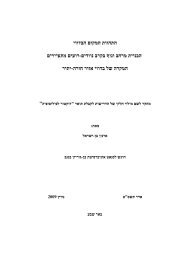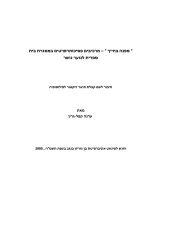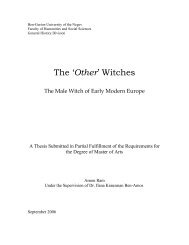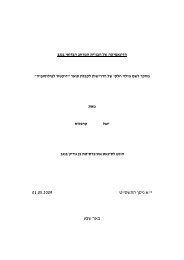Ben-Gurion University of the Negev Jacob Blaustein Institutes for ...
Ben-Gurion University of the Negev Jacob Blaustein Institutes for ...
Ben-Gurion University of the Negev Jacob Blaustein Institutes for ...
Create successful ePaper yourself
Turn your PDF publications into a flip-book with our unique Google optimized e-Paper software.
18<br />
2.6 Main Economics (Agriculture, Industry, Population)<br />
On <strong>the</strong> basis <strong>of</strong> <strong>the</strong> last census ISTAT (2006) <strong>the</strong> total amount <strong>of</strong> resident citizen in<br />
Sicily (390 municipalities) is 4,968,991 (0,3% increase 2000-2001). The provinces <strong>of</strong><br />
Syracuse and Ragusa have respectively 400,764 and 311,760 inhabitants.<br />
Regional economic indicators are lower than <strong>the</strong> national average (ISTAT, 2006). The<br />
main aspects <strong>of</strong> <strong>the</strong> Sicilian economy can be summarized as follow:<br />
• The regional GDP is in line with <strong>the</strong> average <strong>of</strong> <strong>the</strong> sou<strong>the</strong>rn Italian<br />
regions, but is below <strong>the</strong> Italian average;<br />
• The regional demand <strong>of</strong> products and services is mainly oriented on<br />
commodity and goods <strong>for</strong> mass consumption;<br />
• The investment rate is lower than <strong>the</strong> national average;<br />
• The production <strong>of</strong> services is mainly based on public services not <strong>for</strong> sale<br />
3(public <strong>of</strong>fices);<br />
• Export represent 6% <strong>of</strong> GDP<br />
According to <strong>of</strong>ficial statistic published by <strong>the</strong> Osservatorio Economico Ministero per il<br />
Commercio Internazionale (2008) In <strong>the</strong> year 2007 <strong>the</strong> Sicilian import/export balance<br />
was as follow:<br />
Table 1 - Sicilian Import / Export balance in <strong>the</strong> 2007 (after OEMCI, 2008)<br />
Export Million Euro Percentage Import Million Euro Percentage<br />
Refined Oil 4.592 66.2 Crude Oil 9.978 74.7<br />
Basic chemical<br />
products<br />
455 6.6 Refined oil 1.301 9.7<br />
Pipes 270 3.9 Metals 234 1.7<br />
Agriculture 219 3.2 Basic chemical<br />
products<br />
219 1.6<br />
According to <strong>the</strong> European Statistic on Income and Leaving Conditions EU-SILC, in<br />
2005, <strong>the</strong> mean total-income (after tax) per family in Sicily was 20.952 Euro per year<br />
which is about 1750 Euro per month per family. Never<strong>the</strong>less it must be noted that,<br />
50% <strong>of</strong> <strong>the</strong> families are below <strong>the</strong> level <strong>of</strong> 16.658 Euro/year (1400 Euro/month), and <strong>the</strong><br />
Gini coefficient 6 <strong>of</strong> inequality is equal to 0.346, which is far above <strong>the</strong> average national<br />
level.<br />
6 The Gini coefficient is a measure <strong>of</strong> statistical dispersion most prominently used as a measure <strong>of</strong><br />
inequality <strong>of</strong> income distribution or inequality <strong>of</strong> wealth distribution. It is defined as a ratio with values<br />
between 0 and 1: A low Gini coefficient indicates more equal income or wealth distribution, while a high<br />
Gini coefficient indicates more unequal distribution. 0 corresponds to perfect equality (everyone having<br />
exactly <strong>the</strong> same income) and 1 corresponds to perfect inequality (where one person has all <strong>the</strong> income,<br />
while everyone else has zero income). Worldwide, Gini coefficients range from approximately 0.232 in<br />
Denmark to 0.707 in Namibia.
















